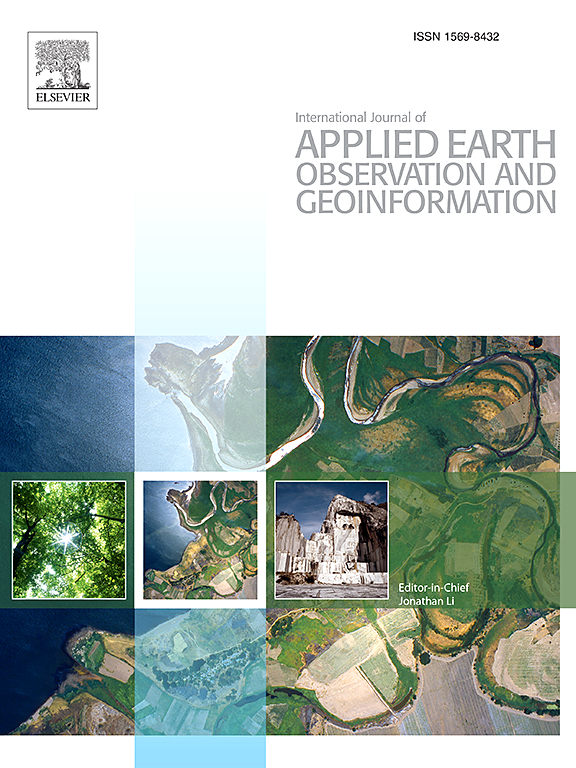Validated visual features of Multi-Perspective imagery with Explainable Machine learning for detecting rural vacant courtyards in North China
IF 8.6
Q1 REMOTE SENSING
International journal of applied earth observation and geoinformation : ITC journal
Pub Date : 2025-06-02
DOI:10.1016/j.jag.2025.104644
引用次数: 0
Abstract
As China’s rural population continues to decline and urbanisation accelerates, the number of vacant courtyards (VCs) has steadily increased. Existing methods for detecting VCs in China face significant challenges regarding data availability, spatial scale, resolution, and reliability, which hinder accurate assessment. This study establishes an innovative approach that evaluates courtyard utilisation status by integrating visual features from horizontal and overhead imagery, distinguishing it from traditional methods that rely solely on remote sensing textures or geometric information. We constructed a systematic set of visual features and employed an interpretable machine learning (XGBoost model) to detect courtyard utilisation status. We identified an optimal model comprising four primary features: from an overhead perspective, plants condition, enclosing wall edge cleanliness, and presence of solar water heaters; and from a horizontal perspective, door and window condition. The research further reveals the asymmetric relationship between these features and courtyard utilisation status, and the spatial heterogeneity underlying this relationship. The model significantly outperforms existing research, achieving an F1 score of 0.834 on the test set while maintaining high accuracy on the external validation dataset. This demonstrates the considerable advantages and potential of this relatively low-cost approach for rapidly detecting VC, providing theoretical support and reliable technical backing for implementing courtyard utilisation monitoring based on image data and sustainable development goals across a broad range of rural areas in the future.

基于可解释性机器学习的多视角图像视觉特征验证:华北农村空院落检测
随着中国农村人口的持续减少和城市化进程的加速,空置庭院的数量稳步增加。中国现有的风险检测方法在数据可用性、空间尺度、分辨率和可靠性方面面临重大挑战,阻碍了准确评估。本研究建立了一种创新的方法,通过整合水平和头顶图像的视觉特征来评估庭院的利用状况,将其与仅依赖遥感纹理或几何信息的传统方法区分开来。我们构建了一套系统的视觉特征,并采用可解释的机器学习(XGBoost模型)来检测庭院的利用状况。我们确定了一个包含四个主要特征的最佳模型:从头顶角度,植物条件,围墙边缘清洁度和太阳能热水器的存在;从水平角度看,门窗状况。研究进一步揭示了这些特征与庭院利用状况之间的不对称关系,以及这种关系背后的空间异质性。该模型显著优于现有研究,在测试集上获得了0.834的F1分数,同时在外部验证数据集上保持了较高的准确性。这表明了这种相对低成本的方法在快速检测VC方面的巨大优势和潜力,为未来在广泛的农村地区实施基于图像数据的庭院利用监测和可持续发展目标提供了理论支持和可靠的技术支持。
本文章由计算机程序翻译,如有差异,请以英文原文为准。
求助全文
约1分钟内获得全文
求助全文
来源期刊

International journal of applied earth observation and geoinformation : ITC journal
Global and Planetary Change, Management, Monitoring, Policy and Law, Earth-Surface Processes, Computers in Earth Sciences
CiteScore
12.00
自引率
0.00%
发文量
0
审稿时长
77 days
期刊介绍:
The International Journal of Applied Earth Observation and Geoinformation publishes original papers that utilize earth observation data for natural resource and environmental inventory and management. These data primarily originate from remote sensing platforms, including satellites and aircraft, supplemented by surface and subsurface measurements. Addressing natural resources such as forests, agricultural land, soils, and water, as well as environmental concerns like biodiversity, land degradation, and hazards, the journal explores conceptual and data-driven approaches. It covers geoinformation themes like capturing, databasing, visualization, interpretation, data quality, and spatial uncertainty.
 求助内容:
求助内容: 应助结果提醒方式:
应助结果提醒方式:


